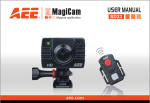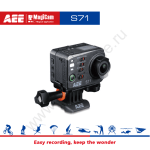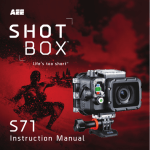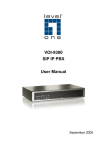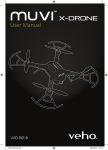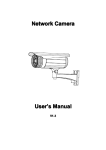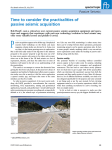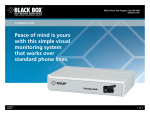Download SD23 manual
Transcript
SD23 175° Ultrawide angle Dynamic HD recording Glass-lens 16-million-pixel shooting digital zooming Waterproof housing and lens-protected design Camera with installation interfaces housing-free light and convenient Cyclic recording (optional) 180° inverse shooting Independent stop key for blinded operations Laser indicator Remote controller with back clips and binding interfaces Low-lux shooting HD output interfaces Built-in dual-microphone recording and external microphones Maximum capacity expansion Automatic and continuous shooting Ultralow and high-temperature environments Contents Precautions................................................................................................................................................. 1 Preface ....................................................................................................................................................... 1 Warranty .................................................................................................................................................... 2 Overview .................................................................................................................................................... 2 Features...................................................................................................................................................... 3 Structure .................................................................................................................................................... 5 Use and Installation.................................................................................................................................... 6 Preparations ............................................................................................................................................... 7 Parameter Settings ..................................................................................................................................... 9 Operations ...............................................................................................................................................14 Storage and Play of a File .........................................................................................................................23 Installation and Use of a Backup Battery (D23).........................................................................................24 Power Supply ...........................................................................................................................................25 Articles in the Packing Box........................................................................................................................25 Optional Accessories ................................................................................................................................26 Technical Specifications............................................................................................................................27 Precautions for the Waterproof housing ..................................................................................................28 Precautions for the 3M Dual-side Sponge Rubber ....................................................................................28 Notice ......................................................................................................................................................28 aee.com Precautions When using the SD23 video camera, adhere to the following precautions: 1. Do not drop, knock or shake the video camera. 2. Do not put the video camera close to an object that generates strong magnetic field, such as a magnet or a motor. Do not put the video camera close to an object that emits powerful radio waves, for example, an antenna. Strong magnetic field may cause faults on the video camera or damage the image / voice data. 3. Do not expose the video camera to high temperature or direct sunshine. 4. Do not put the memory card close to an object that generates strong magnetic field, such as a television set, a speaker, or a magnet. Do not put the memory card in a place where static electricity is easily generated. 5. Disconnect the power supply to stop recharging the battery immediately when over heat, smoke, or peculiar smell occurs during recharging. 6. Keep the video camera out of reach of children during recharging, because the power cable may cause asphyxia or electrical shock on children. 7. Store the video camera in a cool, dry, and dust-free place. Preface Thank you for purchasing AEE SD23 series compact high-definition (HD) digital video camera, which has the following characteristics: ● Ultra small size and integrated structure ● User-friendly interfaces ● Easy operations ● Hand-free shooting to facilitate shooting of real scenarios at any time and place ● Superior recording performance thanks to dynamic HD shooting technologies, providing you with exciting video shooting experience This manual describes how to install and use the SD23 video camera. It also provides information about use, operations, installation precautions, and technical specifications of the SD23 video camera. Before using the SD23 video camera, read and understand this manual carefully and keep it properly for future use. Designed to meet the professional requirements, AEE SD23 video camera will serve you in a long term. -1- aee.com Warranty This product has been certified by certification bodies for compliance with related safety regulations and specifications issued by the federal communications commission (FCC) and council of Europe (CE). Overview The SD23 video camera is a compact high-end HD digital camera intended for professional applications. It provides the following functions: ● Performs industry-leading HD digital shooting. ● Stores voice data. ● Displays images in real time. ● Performs video recording. ● Takes pictures. ● Displays time. ● Provides laser indication. ● Performs wireless remote control. ● Performs 10X digital zooming. ● Connects to an external special-purpose microphone. ● Performs USB 2.0 high-speed data transmission. ● Recharges the battery in USB mode. ● Accessories are available to facilitate shooting at any time and place. Multiple patents of invention and technology are integrated in the SD23 video camera. Dispose of properly. Recycle it for a greener earth! -2- aee.com Features The SD23 video camera has the following features: ● Provides 175° ultra-wide-angel f/2.8 lens. ● Provides a special-purpose HD lens, which supports 1080P, 1080i, 960P, and 720P HD video recording. ● Takes 16M pixels pictures in 4608x3456 resolution ● Performs 10X digital zooming. ● Performs shooting in multiple modes, such as single-key capturing, and automatically continuous capturing. ● Provides unique fast-shot feature, up to 10 photos per second. ● Provides an independent voice recording function for long-time voice recording. ● Provides the remote control function. ● Provides the 180° photo rollover function. ● Connects to an external TFT screen to view the video recording and playback. ● Provides better video effects in multiple video output modes (NTSC system): ● Detects power level of the battery and free capacity of the memory card. ● ● ● ● ● Performs dynamic high-speed video recording, with light and shade environment transient response. Detects light in three modes to meet exposure requirements in different scenarios. Provides night shooting mode with contrast and ISO enhancements, improving the clearness and sharpness of night scenarios. Provides compact and fashionable design. ● ● -3- aee.com ● ● ● ● ● ● ● ● ● ● ● ● ● Provide high color fidelity to present more clear and natural video pictures. A wireless remote controller can remotely control the SD23 video camera for video recording, stopping, and shooting. Provides a unique code paring function to avoid interferences from other remote controllers. Supports playback, deleting files and other operations on the local video camera. Supports 1/4, 1/2, 2, 4, 8, and 16X fast forwarding, fast rewinding, and playback. Supports RTC time settings and time overlapping. Supports USB 2.0. Provides a built-in microphone for high-quality recording. Supports connecting to an external microphone (special-purpose microphone only), Provides a 1/4-inch general-purpose interface to facilitate extension of accessories. Provides multiple types of sport accessories for sport recording. Provides shockproof features to withstand mild drop or knock. Provides an IP68 waterproof housing, withstanding a diving depth of 100 meters, and two-types of rear-cover deigns. Provides automatic standby for power saving, and supports automatic saving of audio and video data. -4- aee.com Structure 1. TFT screen 2. Menu key 3. Upward key 4. Leftward key 5. Downward key 6. Playback key 7. OK key 8. TFT screen lock knob 9. Wrist strap hole 10. Buzzer 11. SD card slot 12. Rightward key 13. A 14. Record key 16. Power switch 17. Microphone 18. Operating/Recharging indicator (Red) 19. LCD segment screen 20. Shutter key 21. Stop key 26. USB output interface 27. Threaded interface 22. Lens 25. HDMI output 24. Laser indicator -5- aee.com Use and Installation The SD23 video camera can be hand-held or used with hand-free accessories. It can be installed at your desired place or, after being equipped with a waterproof housing, placed in water for shooting underwater sceneries. How to install the SD23 video camera (1). Assemble the TFT screen onto the video camera TFT screen video camera Assemble the TFT screen onto the video camera (2). Put the SD23 video camera into the waterproof housing video camera Waterproof housing Put the video camera into the waterproof housing ** To remove the TFT screen, press the PUSH snap button and then remove it.** 2. Installing the Remote Controller The SD23 video camera is equipped with an independent remote controller, which can be placed at different positions, depending on the accessories. -6- aee.com Preparations Before using the SD23 video camera, complete the following preparations: ① Power on the SD23 video camera and check the power level Turn the power switch to the “ON” position to initiate the system. After the red indicator is on, the corresponding symbols on the LCD screen turns on and then the system enters the preview state. On the LCD segment screen, you can find the following information: A A” “ Recording mode: The current recording mode is displayed on the LCD segmen screen. The icon indicates the video mode, whereas the icon ” “ indicates audio mode. B Photo mode: The ” “ (shooting) icon is displayed on the screen. This icon blinks once for each shooting. C Power symbol: The ” “(power supply) icon is displayed in the upper-right corner. When the system is working, this icon is constantly on. If this icon disappears, it indicates the SD23 video camera is in power-off or standby state. “key once to display the duration of the video video, for example, ”005:20“. In the preview state, press the “ recording, and press the “Stop“key once to hide the duration. . Note: The duration for video recording on the LCD segment screen is synchronously displayed with that on the TFT screen. ”(battery capacity) icon is displayed in the bottom-left corner. This icon indicates E Battery capacity indication: The” the battery level when the video camera is powered on. The more bars the power indicator has, the more power the battery has. Note: When the video camera is in the standby or power-off state, the power icon is not displayed. F USB connection mode: The “ ”(USB mode) icon indicates whether the video camera has been connected to a computer. When the video camera is powered on and connected to a computer, this icon is lit with the green indicator on the left side blinking slowly. When the video camera is not connected to a computer, this icon is not displayed. “(TF card capacity) icon is displayed in the bottom-right corner, indicating the TF card capacity indication: The ” available space of the TF card. The more bars the power indicator has, the more free space you have. If the TF card is full, the green indicator on the left side is constantly on. At this time, on the TFT screen, you can find the following information: camera is ready for video recording. -7- aee.com B Battery capacity: The ” “(battery power) symbol is displayed in the upper-left corner, indicating the battery level. D Available storage capacity: If a memory card is available upon power-on of the video camera, the ” ” (free space of the memory card) icon is displayed in the bottom-right corner. E There is no response for “< ” and “>” keys in the preview state. F When using the supplied power supply or USB cable to recharge the battery, the "Working/recharging red indicator" on the top of the video camera blinks slowly. The red indicator will be constantly on upon full recharging. The recharging time lasts for about three hours. Note: Before using the video camera, check whether the battery has sufficient power. If the power level is low, use the power adapter supplied with the video camera or USB cable to recharge the battery. The "Working/recharging red indicator" blinks slowly during the recharging. Upon full recharging, the red indicator is constantly on, and the “ ” (battery power) symbol is displayed on the TFT screen. ② Formatting the Micro SD card The Micro SD card must be a high-speed card. Before video/audio recording and shooting pictures, format the Micro SD card on the SD23 video camera. If a Micro SD card has been used on other devices, it should also be formatted on the SD23 video camera for normal use. Note: Before formatting, make sure the files in the memory and Micro SD card are not needed. Even the locked files on the video camera can be removed in formatting. ③ Setting the data and time To set the date and time, perform the following operations: M” key to display the menu interface. >” to enter the “ ” system setup interface. +”or ”–“ to display the “Date / Time” menu. OK” to display the “Date / Time” interface shown as follows: The digits under the cursor will turn blue and adjustable. -8- aee.com +” or “–” to adjust the date or time. OK” after adjusting the date or time. M” key to exit the interface. Parameter Settings To set parameters, perform the following operations: M ” key to display the menu interface. <” or “>” key to choose a left or right option from the menu interface. +” or “–” key to choose an upper or lower option from the menu interface. Note: After power-on, the video camera adopts all the preset settings, except for audio recording mode. You can change settings as you desire. ① Set video camera parameters. a. Exe.: Select ” “(the default mode) for video recording and ” “ for audio only. b. Resolution for video recording: Select the desired resolution for video recording. You can set this parameter to the For the PAL system For the NTSL system -9- aee.com The following example shows the same picture in different views: The preceding views apply only to the 1080P or 1080i HD video recording and photo modes. You can select a view angle as you desire. d. Bit rate: This parameter can be set to High bit rate ( ) or Normal ( ). If this parameter is set to High, pictures are clearer, but the file size increases. e. Laser SYNC video: Select” “to enable the laser indicator, or select” “(the default option) to disable the laser indicator. f. Pre-video: In the preview state, press the ”M” key to enter the video recording setup interface, choose”Pre-video” to enable the pre-video recording function. In this mode, press the “Video key” to enable the pre-recording function, that is the video recording starts without part of the video recording file. g. Auto video: In the preview state, press the “M” key to enter the video recording setup interface, choose “Auto video”, and set the count-down time before the automatic video recording. The available options are OFF, 5 s, 10 s, or 20s. h. 180°photo rollover: In the preview state, press the “M” key to enter the video recording setup interface, and choose “180° Photo Rollover”. This function allows you to shoot photos from any angle. The 180° photo rollover function is unavailable for video -10- aee.com i. Display time: In the preview state, press the M key to enter the video recording setup interface, choose “DISPLAY TIME”. If you set this parameter to “ON”, the video camera automatically records the date and time during video recording and displays them in the bottom-right corner of the screen. If you set this parameter to “OFF”, the video camera does not display the date and time during video recording. (The display time function is unavailable for video recording in 1080i, WVGA/100fps, and WVGA/120fps modes.) Note: a. In audio recording mode, press the “Video” key once to start audio recording. The audio recording duration is displayed in the upper-right corner of the TFT screen, and the green indicator blinks slowly. Press the “Stop” key to stop and store the currently recorded audio file. In such a situation, the green indicator is off, and the red indicator is constantly on (the operation prompt is displayed on the LCD segment screen), and the video camera restores to the state for audio recording. b. During audio recording, the video camera responds only to the “Stop”, “Power off” keys. c. When the laser SYNC video function is enabled, the laser icon is displayed in the upper-left corner of the preview screen, indicating that the video camera is in such a shooting mode. The laser will be turned when starting video recording, and turned off when stopping video recording. d. When the pre-video and audio video functions are both enabled, press the “Video”key to automatically record the time in reverse counting mode; press the “Video” key again, the last a few seconds of the pre-recorded video will be saved as the starting part of the video recording file. ② Set camera parameters. a. Resolution: Select the required resolution for shooting. You can set this parameter to “8.0M”, “12.0M”, or “16.0M”. b. Single shot : When the camera is set to the single-key shooting mode, one picture is captured when the “Photo” key is pressed once. c. Fast shot: three fast-shot modes are available: 3 p/s, 6p/s and 10 p/s (photo/second). Select the desired mode and press Photo key, the camera will take pictures for one second with prompt tones. -11- aee.com d. Auto cont. capture: Pictures is captured at intervals of 0.5s, 1s, 2s, 3s, 5s, 10s, 20s ,30s or 60s until the “ Stop ” key is released, the memory card is full, or the battery power is low. e. Timed shooting: Select the reverse-counting time for auto-shooting (This parameter can be set to OFF, 3s, 5s, or 10s), and choose “Timed Shooting” and press the “M” key to return to the preview state. Then press the “Photo” key to start reverse counting timer. When the preset time is reached, the auto-shooting indicator blinks, and the camera takes a picture. To restore to other shooting modes, set “Timed Shooting” to “OFF”. Otherwise, the camera maintains in timed shooting mode. f. Display time: In the preview state, press the “M” key. On the setup interface, choose “Display Time”. If you set this parameter to ON in advance, the camera automatically records the date and time during shooting and displays them in the bottom-lower corner of the photo. If you set this parameter to OFF in advance, the camera does not display the date and time during shooting. (The display time function is unavailable for photo shooting in 1080i, WVGA/100fps, and WVGA/120fps modes). Note: 1. The timed shooting function and other shooting functions cannot be simultaneously enabled. Set Timed shooting to “OFF” to restore to the other shooting modes. Otherwise, the camera is defaulted in timed shooting mode. 2. In single shot mode, the Auto cont. capture parameter is automatically set to OFF. 3. If the Auto cont capture parameter is set to 1s, the time display function is unavailable. ③ Set system parameters a. Prompt tone: Set this parameter to “ON” to enable the tick tone or OFF to mute the tick tone. Note: This parameter cannot be set to mute the prompt tones for shooting and video recording. Instead, this parameter can only be set to mute the tone generated upon pressing a key on the TFT screen and no-operation prompt tones. b. Status indicator: After choosing the required menu, set this parameter to ON (turning on the status indicator) or OFF (turning off the status indicator). By default, set this parameter to ON. every 15 minutes. When this parameter is set to OFF, a recorded video file is automatically saved once by segment every 30 minutes. d. Auto to standby: Set this parameter to OFF, 2 mins, 5 mins, or 10 mins. You can select the time for automatic standby. After presetting the time, the system starts counting time when there is no task or operation. When the preset time is -12- aee.com reached, the SD23 video camera disables the input/output and enters standby mode. During time counting, the system restarts counting time if any tasks or operations are carried out. During the standby period, the SD23 video camera screen appears for two seconds during switchover between the NTSC and PAL systems, and this situation is normal. Note: Before using the video camera, select NTSC or PAL depending on your region. After the video system is selected, the light source frequency also changes to avoid image blinking during video recording. f. Contrast: Set this parameter to “Standard” by default. To improve the image effect during night shooting, set this parameter to “Enhanced”. g. ISO sensitivity: This parameter is set to Auto by default. To improve the image effect during night shooting, set this parameter to “Low lux”. h. Metering: Set this parameter to “Average” by default to ensure the general exposure effect. If the central area is dark but the surrounding area is bright, set this parameter to “Central Area” to improve the imaging effect in the central dark area. If the central area is bright but the surrounding area is dark, set this parameter to “Central Spot” to improve the imaging effect for the surrounding dark area. i. Language: Press the “<” or “>” key to choose your desired language. j. Date/time: You can adjust the date and time, which are overlapped in the bottom-right corner of a video or shooting file during video recording or shooting. k. Format: Select “Format” to remove all the files. Note: If no memory card is inserted, the video camera formats its built-in memory. If a memory card is inserted, the video camera formats the memory card rather than its memory. m. Recover factory setting: This parameter restores all parameter settings to the factory settings. After you set this parameter, the system displays all the menu options in english. Press the M key to display menu options. Press the “<” or “>” key to display the “System Setup” menu. Press the “–” key, and choose “Language”.Then set the system in your desired language. After resetting to the factory setting, the system displays 01/01/2012 00:00 for the time. Note: When selecting a state from a submenu, press the “M” key for a backward operation, and press “OK” for confirmation. -13- aee.com Operations 1. Insert a Micro SD card into the SD23 video camera. Note: Use a branded Micro SD card, for example, Transcend Class 10 memory card. 2. Powering on the SD23 Video camera Turn the power switch to the ”ON” position to power on the SD23 video camera. At this time, the red indicator is on, and the SD23 video camera changes to the preview state. Note: a. If the battery power is low, the” “symbol is displayed on the TFT screen together with a promot. b. If no Micro SD card is inserted, no symbol is displayed in the bottom-right corner of the TFT screen. 3. Recording a Video In the preview state, press the ”Video” key to start video recording. The video recording duration is displayed in the of the video camera blink slowly. The recording duration is correctly displayed on the LCD segment screen. During video recording, the video camera responds only to operations for the zoom out (+) and zoom in (–) keys. Press the “Stop” key once to stop and save the currently recorded video file, and the video indicator (green) on the front side is off. The video camera restores to the preview state. The recording duration disappears on the LCD segment screen. Note: a. During video recording, turn the power switch to the “OFF” position to power off the video camera after saving the currently recorded file. b. During video recording, if the battery power runs low, the system saves the currently recorded file and enters standby mode, displaying a prompt of “Low battery ” on the TFT screen, until the video camera is powered off. c. During video recording, if the Micro SD card is full, the system saves the currently recorded file. The system also displays a message “Card full” on the TFT screen, indicating that the Micro SD card is full. In addition, the duration for video recording stops on the LCD segment screen, and the system restores to the preview state. d. In cyclic recording mode, the system automatically saves a file every 15 minutes. (The cyclic recording function and the pre-video function cannot be simultaneously enabled.) e. If the D23 backup battery is provided and fully recharged, the video camera can continuously record video programs for about four hours and record audio programs for about seven hours. -14- aee.com rollover functions. In 1080i/50 and 1080i/60 modes, the video camera does not support the time display function. g. In audio recording mode, the volume cannot be adjusted by pressing the “+” or “–” key. In playback, however, the volume can adjusted by pressing the “+” or “–” key. h. If the video camera provides a TFT screen and is in the preview state, after using a HDMI patch cord to connect the video camera to a HD display device, you can perform basic operations for the video camera on the HD display device (These basic operations, however, cannot be performed if no TFT screen is available on the video camera). 4. Taking a Picture Before taking a picture, perform the following operations to set the image resolution. — Press the “M” key to display the setup interface. — Press the “>” key to display the camera setup interface ( ). — Press the “+” or “–” key and choose “Image Resolution”. — Press “OK” to display the resolution setup menu. You can set the resolution to any of the following three modes: 8M, with an image resolution of 3200 x 2400. 12M, with an image resolution of 4096 x 3072. 16M, with an image resolution of 4608 x 3456. Four photo shooting modes are available for the video camera. a. single shot (the default mode) In the preview state, press the “Photo” key once to take a picture while the system generates a click tone. The green indicator on the front side of the video camera also blinks once (the shooting icon on the LCD segment screen blinks once), and the video camera restores to the preview state. b. Fast shot On the camera setup interface, press the “+” or “–” key and choose “Fast shot”. Press “OK” to display the interface. Press the “>” key, and choose 3 p/s or 6p/s or 10 p/s (photo/second). Press “OK” again to exit the interface. Press the “M” key to exit the camera setup interface. After setting is complete, the SD23 video camera continuously takes three pictures or six pictures or ten pictures when you press the Photo key once. -15- aee.com c. Auto cont capture On the camera setup interface, press the “–” key and choose “Auto Cont Capture”. Press “OK” to set the time interval for continuous shooting to OFF, 0.5s, 1s, 2s, 3s, 5s, 10s, 20s ,30s or 60s . Press the “>” key to set the time interval. Press the “M” key to exit the setup interface. At this time, if you press the “Photo” key, the SD23 video camera takes a picture at each interval until you press the “Stop” key to cancel shooting. d. Timed shooting On the camera setup interface, press the “+” key and choose “Timed Shooting”. Press “OK” to set the time in auto-shooting mode to OFF, 3 s, 5 s, or 10 s. Press the “>” key, and choose “Timed Shooting”. Press “OK” again to save and exit the interface. Press the M key to exit the camera setup interface. After setting is complete, the SD23 video camera starts reverse-counting timer when you press the Photo key once. When the preset time is reached, the SD23 video camera takes a picture. 5. Recording an Audio File To record an audio file, perform the following operations: — Press the “M” key on the video camera setup interface, choose “ Exe. ”., and then press “OK” to display the video and audio options. — Press the “<” or “>” key, and choose” “for audio only, and press ”OK” again. Press the“ M ”key to exit the setup interface. The system gets ready for audio recording. — Press the “Video” key to start recording an audio file. At this time, the green indicator blinks slowly. The video camera also displays the audio recording symbol on the TFT screen and starts counting time. In addition, the recording duration is correctly displayed on the LCD segment screen. — Press the “Stop” key to save and stop the currently recorded audio file. At this time, the green indicator on the front side blinks slowly. The video camera restores to the preview state for audio recording. The recording duration also disappears on the LCD segment screen. After audio recording is complete, press the “M” key. On the system setup interface, choose “ Exe. ”., and press “OK” to display the “Audio” option. Press “OK” to display the video and audio options, and choose “Video”. Press “OK” again to exit the setup interface. The video camera restores to the preview state for video recording. -16- aee.com Note: a. Power on the video camera again to restore to the video recording mode. After audio recording is complete, you can also press the ” “ key twice to restore to the video recording mode. b. Press and hold the Stop key for two seconds to directly change the video camera to the ready state for audio only. 6. Playing Back a File You can view the recorded audio/video and photo files on the SD23 video camera. To view a file, perform the following operations: — Press the “ ”key to display the playback interface. Press the“ ”key again to exit the playback interface. — Select ” “(the video files interface) to view a recorded video file. Select ” “(the photo files interface) to view a photo file. Select ” “(the mixed file interface) to view all the video, audio, and photo files. If there are many files, it takes a few seconds time for the video camera to display the preview interface. To play a video file, perform the following operations: On the video file interface ( ), press the “+”, “–”, “>”, or “<” key to display all the files displayed in thumbnails. Select the required file, and press OK to play it. When playing a video file, you can use the following keys: Key Description Key Description + Turns up the sound volume. – Turns down the sound volume. Plays a file in slow rewind mode when you press and hold this Plays a file in slow forward mode when you press key for a long time. and hold this key for a long time. < > Plays a file in fast rewind mode when you press and hold this Plays a file in fast forward mode when you press key for a short time. and hold this key for a short time. Resets and plays a file from the beginning when your press this Starts or suspends playing a video file when you key. OK press this key. Returns to the playback interface when you press this key again. Note: You can set the fast forward and rewind functions to a 2-, 4-, 8-, or 16-X speed. You can also set the slow forward and rewind functions to a 1/2- or 1/4-X speed. During the slow or fast play, you can press OK to resume normal playing. -17- aee.com To view a photo file, perform the following operations: On the photo file interface ( ), press the “+”, “–”, “>”, or “<” key to display all the files displayed in thumbnails. Select the required file, and press OK to view it. When viewing a photo file, you can use the following keys: Key + < Description Key Description Zooms in a picture. Zooms out a picture. In zoom-in mode, locks a picture and moves it downwards when – In zoom-in mode, locks a picture and moves you press OK. it upwards when you press "OK". Moves a picture rightwards. > Moves a picture leftwards. Resets and plays a file from the beginning when your press this key. In zoom-in mode, switches between the "+" OK Returns to the playback interface when you press this key again. and "–" keys. 3) Playing an Audio File To play an audio file, perform the following operations: On the mixed file interface ( ), press the “>” or “<” key to display all the audio files in” “mode. Select the required file, and press OK to play it. When playing an audio file, you can use the following keys: Key Description + Turns up the sound volume. < No function is provided. Resets and plays a file from the beginning when your press this key. Returns to the playback interface when you press this key again. Key Description – Turns down the sound volume. > No function is provided. OK Starts or suspends playing an audio file when you press this key. Note: The fast forward and rewind functions are not provided for playing an audio file. -18- aee.com 7. Deleting, Protecting, and Automatically Playing a File In playback mode, you can press the ”M“ key to delete, protect, and automatically play a file. 1) Deleting a File On the video, photo, or mixed file interface, you can delete a video file, a photo file, or all the files. To delete a file, perform the following operations: Select a file to be deleted. Press the ”M“ key to display the operation interface. The following options are displayed on the operation interface. ● Delete single: deletes a picture. Press OK to display the options for deletion. Select “ ”or “×”based on the displayed message. An option marked with “ ” will be deleted. ● Delete all: deletes all the unprotected pictures. 2) Protecting a File On the video, photo, or mixed file interface, you can protect a video file, a photo file, or all the files. To protect a file, perform the following operations: Select a file to be protected. Press the ”M“ key to display the operation interface. The following options are displayed on the operation interface. ● Protect single: protects a file. Press “OK” to display the options for protection. After you select a file to be protected and press “OK”, the system automatically returns to the playback interface. ● Protect all: protects all the files. Press “OK” to display the options for protection. After you select all the options to be protected, the system automatically returns to the playback interface. ● Unlock single: unlocks a protected file. Press “OK” to display the options for protection. After you select a file to be unlocked and press “OK”, the system automatically returns to the playback interface. ● Unlock all: unlocks all the protected files. Press “OK” to display the options for protection. After you select all the files to be unlocked and press “OK”, the system automatically returns to the playback interface. Note: For a protected file, the” “icon in gray is displayed in the bottom-left corner of the preview interface. After being unlocked, a file is unprotected, and the” “icon in blue is displayed in the bottom-left corner of the preview interface. A protected file cannot be deleted, but can be deleted by a formatting operation. -19- aee.com 3) Automatically Playing a File In the photo file interface, the SD23 video camera can automatically play photos in sequence every five seconds. To automatically play a file, perform the following operations: Enable the playback function, and press “OK”. 8. Using a Remote Controller The SD23 video camera is equipped with a remote controller, which is used for control of video recording, shooting as well as turning on/off a laser. After you pressing the corresponding key, the red indicator on the remote controller blinks once. The following figure shows the functional keys of the remote controller. To match the functions of the remote controller with those of the SD23 video camera one to one, perform the following operations for code pairing before using the remote controller. Photo key Stop key Press and hold the Photo key for five seconds to enable or disble the laser function — Press the Photo key on the SD23 video camera in power off mode. — Turn the power switch to the ON position. — Release the Photo key. Then hold the Photo and Stop keys on the remote controller once within five seconds. After successful code pairing, the SD23 video camera generates the tick tone twice. Note: a. To check whether code pairing is successful, use a wireless remote controller to control the SD23 video camera. The control functions involve starting/stopping video recording, shooting, waking-up in standby mode, and turning on/off the laser indicator. For each operation, the SD23 video camera generates a tick tone, indicating that the operation takes effect. When you use the remote controller to stop video recording or turn off the laser indicator, the SD23 video camera generates a tick tone twice. b. The remote controller must be used within a distance of up to 10 meters in an obstacle-free and horizontal angle. -20- aee.com The SD23 video camera enters preview mode after power-on. If no task or operation is carried out within the preset standby time, the system automatically enters the standby mode to save power. To wake up the camera from standby state, you can press the “Video” “Photo” or “Stop” key, or press any key on the remote controller. Note: a. In the standby state, the system does not start when you press any key on the TFT screen. b. In the standby state, no information is displayed on the LCD segment screen. display device, the SD23 video camera can still implement all its functions. 10. Connecting the HDMI Output In the preview state, connect the SD23 video camera to an HD display device using an HDMI patch cord. After being connected to the HD display device, the SD23 video camera can implement all its functions. Note: Incorrect removal of the HDMI patch cord may result in exceptions on the SD23 video camera. After being restarted, the SD23 video camera can restore to the normal state. a. To connect the SD23 video camera in USB mode, perform the following operations: If no battery is provided for the SD23 video camera before delivery, connect the SD23 video camera using a USB power adapter to implement all the functions. The corresponding messages are displayed for operations on the LCD segment screen and the TFT screen. b. In the power-on state, connect the SD23 video camera to a computer for accessing the data stored in its memory card and the Micro SD card. The USB connection state icon is displayed on the LCD segment screen, and the green indicator also blinks slowly. c. Incorrect removal of the USB power adapter may result in exceptions on the SD23 video camera. After being restarted, the SD23 video camera can restore to the normal state. 12. Prompt Tones upon Operations The SD23 video camera can generate various prompt tones upon operations. a In normal cases, the SD23 video camera generates a tick tone, indicating that the operation is valid when you press the -21- aee.com b Upon stopping video recording, the SD23 video camera generates a tick tone twice, indicating that the video recording operation stops. c If code pairing is successful upon a power-on operation, the SD23 video camera generates a tick tone twice, indicating that the code pairing operation is successful. d During video recording, the SD23 video camera does not generate a tick tone when you press the Photo key. e When any operations are performed on the TFT screen, you can enable or disable the function for generating a tone. Specifically, press the M key when the SD23 video camera is in the preview state. Then press the “<” or “>” key to display the Setup menu. Press the “+” or “–” key, and select Prompt tone. f During video recording, the SD23 video camera generates a tick tone twice, indicating that the video recording operation stops when you press the Stop key on the remote controller once. g During video recording, no prompt tone is generated by the SD23 video camera or by the speaker on the TFT screen when you press the Photo key on the remote controller once. h In the standby state, the SD23 video camera generates a tick tone twice, indicating that the main system starts when you press a key on the remote controller. 13. Laser Indicators The SD23 video camera provides laser indicators for warning operations. a After the SD23 video camera is powered on, the laser indicator is turned on when you press and hold the “Video” key for three seconds regardless of the working state. b If the laser indicator is on, it will be turned off when you press and hold the “Video” key for three seconds. c In the standby state, you can also turn on or off the laser indicator. d You can use a wireless remote controller to turn on or off the laser indicator. Note: Pressing the “Video” key for three seconds to turn on or off the laser indicator does not affect the setting of the Laser SYNC video parameter in "Parameter Settings." 14. Turning On/Off the TFT Screen a. After the SD23 video camera is powered on, you can press and hold the Photo key for three seconds to turn on or off the TFT screen. b. The Photo key on the remote controller does not provide the function for turning on or off the TFT screen. -22- aee.com Storage and Play of a File 1. Connecting a USB Data Cable After video recording is complete, you can copy the recorded images to a computer for play by using a USB data cable. You can also remove the Micro SD card from the SD23 video camera and access the image data by using a sensor. The Media Player software is preferred for playing a file. Note: 1. Before removing the USB data cable, power off the SD23 video camera. 2. When the power switch is in the OFF position, you can recharge SD23 the battery on the SD23 video camera. At this time, the red USB interface indicator blinks slowly. Computer 3. When the power switch is in the ON position, you can copy the USB interface USB data cable recorded files from the SD23 video camera to the computer. TV set or monitor or monitor. Note: 1. After connecting to a monitor by HDMI cable, select the proper input source for the SD23 video camera to play files. SD23 AV interface AV data cable TV set AV interface SD23 HDMI interface HDMI data cable TV set or HDMI interface 3. Adjust the parameter settings of the monitor to achieve the optimal display effect. -23- Installation and Use of a Backup Battery (D23) aee.com 1. Installing a Battery You can install the D23 battery onto the SD23 video camera without setting any parameters for power supply, as shown in the following figure: 2. Checking the Battery Power You can gently press the Power key to check the power of the backup battery. The LED indicator on the battery blinks for three seconds in different colors to show the current power. Blinking(green) upon full power Blinking(blue) upon sufficient power Power Blinking(red) upon insufficient power 3. Recharging the Battery You can connect the standard power unit of the SD23 video camera to the USB recharging interface of the D23 battery or connect a computer to the USB recharging interface of the D23 battery by using a USB data cable for recharging, as shown in the following figure. This backup battery has automatic protection against overcharging and short circuit. The red indicator light keeps flashing when charging the battery and the green indicator light is on when the battery is fully charged. (The battery can be charged for 500 times.) USB data cable During recharging,the red indicator on the SD23 telecamera blinks,but the red indicator on the D23 battery does not blink. MINI USB Note: 1. Do not remove the backup battery randomly. 2. If the SD23 video camera is not used for a long time, recharge the battery every six months to extend the battery life. 3. It takes about 2 hours to fully charge this backup battery by the charger. -24- Power Supply aee.com The SD23 video camera uses a power unit certified by the following authorities. UL mark U.S. Power Certificatation C-TICK mark Australia Power Certification CCC mark China Power Certification PSE mark Japan Power Certification GS mark Germany Power Certification CE mark E.U. Power Certification BS mark U.K. Power Certification Note: The surface temperature of a power unit in use may increase, and this situation is normal. Articles in the Packing Box The articles in the packing box are as follows: SD23 telecamera Bracket TFT monitor Micro SD card Remote controller Power adapter Dedicated waterproof housing AV output cable -25- Standard battery USB cable Backup battery Cloth bag Flat-mounted assembly strap CD ROM Flat-surface accessory User’s Manual aee.com Optional Accessories The optional accessories for the SD23 video camera are as follows: Portable power unit (2500 mAH) Portable power unit (850 mAH) Helmet-top-mounted accessory Soft-and flat-mounted accessory Bicycle-mounted accessory HDMI output cable The precautions for movable accessories are as follows: 1. Use a rubber stopper for removable components. 2. Use the soft- and flat-mounted accessory only on a smooth plane in a car. -26- Bicycle-mounted accessory Back Clip Glass-suction bracket L-shaped helmet accessory aee.com Technical Specifications Technical specifications of the SD23 video camera Option Specifications 175° Number of pixels 16 million CMOS sensor (4608 x 3456) Battery 1000 mAh lithium battery + 1100mAh backup battery Power consumption Continuous duration for video recording Option Specifications 1080P (1920x1080P) 30 frames / second 1080i (1920x1080I) 60 frames / second 960P (1280x960P) 30 frames / second Format for video recording 720P (1280x720P) 60 frames / second (in NTSC system) 720P (1280x720P) 30 frames / second 4 hours (Max.) Continuous duration for audio recording 7 hours (Max.) Standby duration 200 hours (Max.) Audio recording Recharging duration Approximately 3 hours Shooting Recording video files in MO Recording audio files in WA for shooting resolution Capacity of the Micro SD card capacity (SDHC) Operating humidity 15%–85% RH Distance for remote control 10 meter (Max.) Storage temperature -20°C~+60°C Operating system Windows XP 7, or Mac OS Operating temperature -10°C~+50°C Weight 80 g (without the screen) 105 g (with the screen) File storage 30 minutes per segment in normal cases Dimensions (W x H x D) 15 minutes per segment in cyclic recording mode USB interface -27- USB2.0 60 mm x 52 mm x 42 mm Windows Precautions for the Waterproof housing aee.com The waterproof housing is a precision component. When using the waterproof housing, adhere to the following precautions: 1. Do not randomly remove or change the O-ring, key, and lens cover. Otherwise, the waterproof performance deteriorates. 2. Do not put the waterproof housing in a place where corrosive gases are easily generated due to strong acid or alkali. Do not make the waterproof housing in contact with chemical or corrosive objects, such as strong acid or alkali. 3. Do not put the waterproof housing in a place where temperature is high (50°C) or low (-10°C) for a long time to avoid deformation. 4. Do not expose the SD23 video camera to sunshine for a long time to avoid deterioration of the waterproof performance. 5. Before use, ensure that the O-ring is intact, the seal is litter-free, the housing is fully sealed, and the buckle is tight. 6. After using the housing in sea water, wash it using fresh water, clean it, and dry it in a cool place. Precautions for the 3M Dual-side Sponge Rubber When using the 3M dual-side sponge rubber, adhere to the following precautions: 1. Before fixing the 3M dual-side sponge rubber, select a curved or flat surface to ensure proper contact between the sponge rubber and the curved or flat surface. 2. Before using the 3M dual-side sponge rubber, clean the surface where the sponge rubber is attached. 3. Before attaching the 3M dual-side sponge rubber, heat the surface of the sponge rubber using an electric blower, especially in a place where temperature is lower than -20°C. Notice When using the SD23 video camera, pay attention to the following notice information: 1. During continuous use, the body temperature of the SD23 video camera increases. This situation is normal. 2. If the SD23 video camera is not used for a long time, remove and maintain the battery properly, and recharge the battery every six months to ensure the battery performance. 3. During recording, enabling the digital zooming function may affect the image quality. 4. Shooting view angles are slightly different in different working modes of the video camera. 5. If a video file is large, a computer or a special-purpose player is preferred for smooth play. -28- aee.com -31- aee.com -32- aee.com -33- aee.com -34-





































